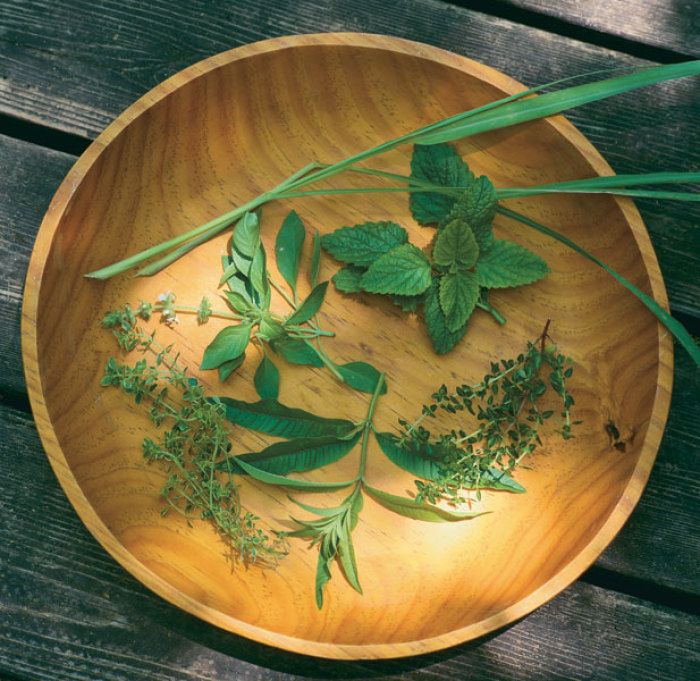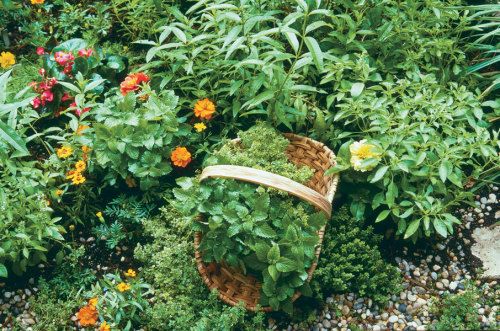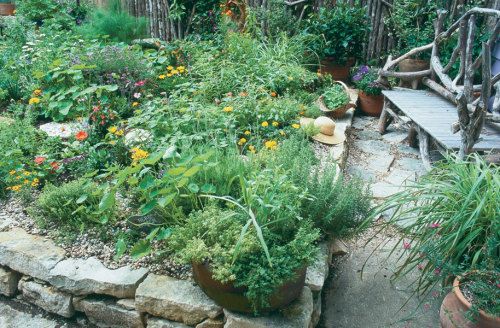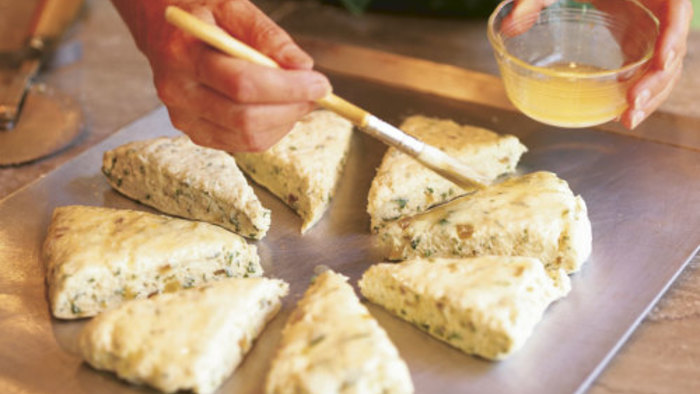
by Lucinda Hutson
August 1997
from issue #10
I fondly remember my Grand Aunt Mary’s lemon verbena bush that seemed as tall as I when I was five. I delighted in weaving fragrant crowns from its branches. I would rub the scratchy leaves and the air would smell like lemonade. I couldn’t believe that lemons did not grow on that “tree.”
Today, I understand that the compound citral occurs in the essential oils of lemon verbena as well as lemon balm, lemon thyme, lemon basil, and lemongrass. Long favored in soaps, perfumes, and potpourris, these evocative herbs also offer ethereal aroma and essence to many foods. And they provide color, fragrance, and texture to the garden.
Although grocery stores now sell bunches of fresh herbs, I have seldom found the lemon-scented ones. The tender leaves of lemon balm, lemon verbena, lemon thyme, and lemon basil bruise easily, and they are simply more flavorful when freshly picked. All the more reason to grow them yourself. Stalks of lemongrass, on the other hand, have a longer shelf life, and many stores now carry them.
Lemon verbena (Aloysia triphylla). My only regret in growing this South American native is that it does not reach the lofty proportions here that it does in its homeland, where it may attain 20 ft. Lemon verbena’s narrow, pointed, rough-textured leaves are exquisitely redolent of lemons.
Panicles of tiny, white, star-like flowers appear on lemon verbena in the summer, and when gently rubbed, fill the air with wafts of ambrosial perfume. These flowers seldom set seed; plants can be propagated from 4-in. semi-hard cuttings that root best in late summer in damp sand. Give this shrubby plant plenty of room in the garden since it will reach 3 ft. to 5 ft. Its woody branches will get leggy, so keep them pruned by continually snipping sprigs.
In Zone 8 or warmer, this tender perennial will winter over if mulched and grown in a protected area with a southern exposure. Gardeners in climates with prolonged hard freezes may choose to grow the plant in a large pot that can be taken inside for the winter. The plant will probably lose most of its leaves indoors, so allow it to lie dormant with only minimal watering.
Lemon balm (Melissa officinalis). Lemon balm, with its pretty heart-shaped leaves and scalloped edges must be nature’s valentine. No wonder the 16th-century herbalist Gerard believed that drinking balm in wine “driveth away all melancholy and sadness.” Another name for lemon balm is Melissa, from the Greek word for bee, since its intoxicating nectar seduces bees when the cream-colored blossoms poke their heads out from the leaves.
Lemon balm makes an attractive border plant, or a nice potted specimen. In the spring, propagate with root cuttings made by lifting small sections from the mother plant. Seeds sown in spring germinate easily when soaked overnight before planting.
Lemon balm is not quite as unruly as its sister mints. It grows 1-1⁄2 ft. to 2 ft. in height and width. But keep an eye on it because it has a tendency to spread. Snip its long stems to ensure a healthy plant, especially after flowering. Snipping flowers will prevent their setting seed when you want to limit regeneration.
‘Aurea’, a gold and green variegated type of lemon balm, is hardier in cooler climates; it reverts to green in warmer areas. A bronze discoloring of lemon balm’s leaves results from too much heat or too much water. Feed lightly.
Sometimes detrimental insects seek lemon balm’s tender leaves. Spider mites attack (as they do lemon verbena) during hot, dry summers, and aphids sometimes call. Both may be discouraged by frequent hard sprayings from the hose, or by insecticidal soap, if necessary.
Lemon basil (Ocimum basilicum ‘Citriodorum’). All basils love sunshine and this one just sits and sulks if not given enough. Do not set out transplants or sow seeds until the soil is good and warm. Like all basils, this one likes rich, moist, well-drained soil with light applications of fish emulsion and liquid seaweed. Feed lightly as too much fertilizer may increase the size of the leaves but decrease their flavor. Even more than other basils, lemon basil has a proclivity to set seed, so pinch back the flowers and harvest leaves regularly.
Pinching back stems often will promote branching and a plethora of delicate leaves. Lemon basil’s demise is brought about by the first light freeze, so harvest it at any hint of winter.
Renées Garden Seeds offers a variety called ‘Mrs. Burns’ Lemon’ (formerly called ‘Maenglak Thai’) lemon basil that is quite vigorous. In my warm climate, I have fared well with ‘Mrs. Burns’, a prolific variety originally from Canada.
Lemon thyme (Thymus citriodorus). The fresh scent of lemons is packed into the tiny elliptical leaves of this evergreen perennial. Lemon thyme appears in upright and creeping varieties in green, golden, and silver hues. The sprawling nature of the creeping thymes makes them a natural in rock gardens and as border plants.
The stems of lemon thyme become woody with age; because of this and the dieback caused by summer’s heat, I replace my plants every year or so, and continually cut woody stems to promote growth. To prevent root disease, I add a handful of gravel when I plant thyme. Plants are easily propagated by cuttings or by layering.
Lemongrass (Cymbopogon citratus). Lemongrass’s long, bluish-green leaves sway in the breeze, adding height and airy texture to the garden. The spear-shaped leaves grow in tufts from fibrous stalks attached at a common base. It reaches 3 ft. to 5 ft. in height, and a few clumps may increase to more than 2 ft. in width in one season, providing plenty to share with friends. To harvest or propagate the stalks, carefully divide them by cutting the bulbs away from others in the clump with a sharp knife, leaving some of the roots intact.
Native to the tropics of Southeast Asia, lemongrass thrives in rich, moist, well-drained soil but adapts to drier conditions, though the stalks will not be as flavorful. Though I have been successful in overwintering my plants by mulching them heavily, gardeners in areas where temperatures fall below 20°F should dig up their plants and bring them indoors for winter.
I grow my lemon herbs in a special garden, highlighted by sunny annual flowers like golden calendulas, chamomile, gazanias, zinnias, and ‘Lemon Gem’ marigolds. The garden is a blend of texture, fragrance, and much good cheer.
For the love of lemon
Lemon verbena: Tender perennial; mulch heavily or bring in. Full sun to part shade (in hot climates). Loose, sandy soil.
Lemon balm: Hardy perennial. Sun with some afternoon shade. Well-drained soil.
Lemon basil: Annual. Full sun. Rich, moist, well-drained soil. Keep flowers pinched.
Lemon thyme: Perennial. Full sun; some shade in the South. Loose, well-drained soil with gravel added.
Lemongrass: Tender perennial; mulch heavily or bring in. Full sun. Rich, moist, well-drained soil; adapts to drier conditions.




















Comments
Log in or create an account to post a comment.
Sign up Log in